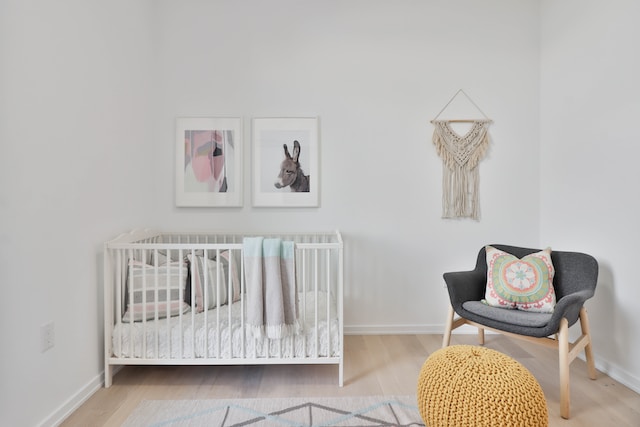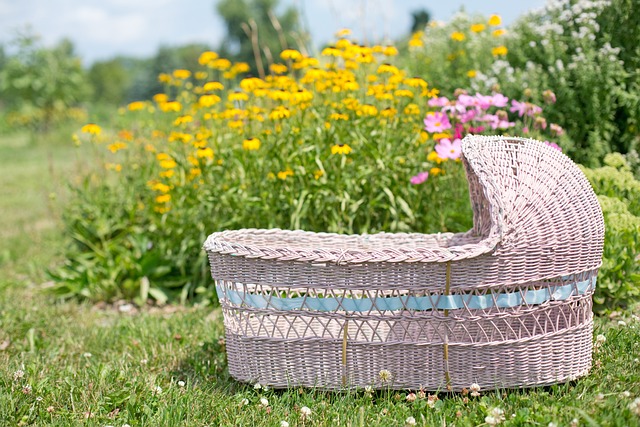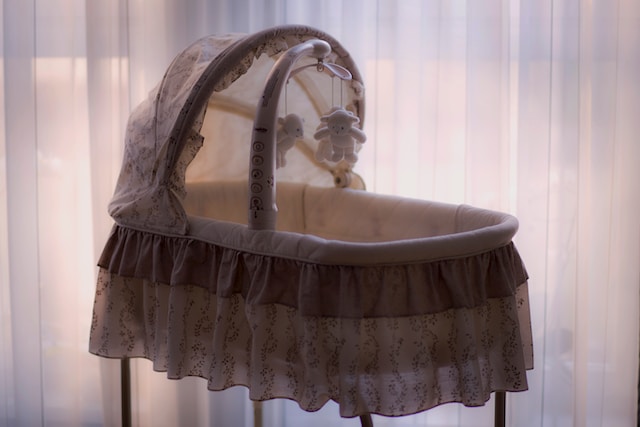A crib can be used for extended periods of time and can also accommodate an active toddler, A bassinet is more portable and temporary for your newborn baby to sleep in during their first few months of life.
What is a crib?
(Photo by Sidekix Media on Unsplash )

A crib is a small bed designed for infants and toddlers. They usually have slatted sides that provide ventilation and allow you to keep an eye on your little one. Cribs come in different styles, sizes, and materials with many features such as teething rails, adjustable mattress heights, storage drawers, and convertible options.
One of the significant advantages of using a crib is safety. Cribs are built to meet strict safety standards set by regulatory bodies such as ASTM International or the Consumer Product Safety Commission (CPSC). These regulations ensure that cribs do not pose any harm to babies while sleeping.
Another advantage of using a crib is longevity. Unlike bassinets which can only be used for several months before outgrowing them, cribs can be used for up to three years depending on their size and weight limit.
However, there are also some disadvantages associated with using a crib. One major disadvantage is space consumption; due to their relatively large size compared to bassinets they require more space in the nursery room or bedroom.
In addition, setting up a crib requires some level of assembly skills which may be challenging for some parents who are not handy with tools. Nevertheless, once assembled properly following manufacturer instructions it provides an excellent sleep solution for your child’s first few years of life!
What is a bassinet?
(Image by Jill Wellington from Pixabay )

A bassinet is a small, cozy bed designed for newborns and young infants. It’s typically used from birth until about four months of age or until the baby starts to roll over, push up on their hands and knees, or sit up.
Bassinets are usually made with a wicker basket or soft fabric sides that allow parents to easily move them from room to room. They come in different shapes and styles – some have a rocking feature while others can be attached to the side of an adult bed.
One of the benefits of using a bassinet is its compact size. It takes up less space than a crib, making it perfect for smaller homes or apartments where there isn’t enough room for a full-size crib.
Another advantage is that bassinets provide easy access to your baby during nighttime feedings and diaper changes since they’re often placed right next to the parent’s bed.
However, as babies grow bigger and more active, they may outgrow their bassinet quickly. Additionally, some parents find themselves having trouble transitioning babies from sleeping in their familiar bassinets into cribs later on.
If you’re looking for something portable and convenient during those early months when your baby needs frequent attention throughout the night – then consider investing in a good quality bassinet!
Crib Vs. Bassinet – Key differences
When it comes to choosing the right sleeping arrangement for your newborn, there are plenty of options available. Two popular choices are cribs and bassinets. While both serve a similar purpose, there are some key differences between them that you should consider.
Firstly, size is an important factor when comparing cribs and bassinets. Cribs tend to be larger than bassinets and can accommodate babies up to 3 years old while most bassinets can only hold infants up to about 6 months old or until they start rolling over or sitting up on their own.
Another difference is portability. Bassinets are usually lightweight and easy to move from room to room while cribs tend to be stationary since they’re heavier and bulkier.
Safety features also differ between the two. Cribs often come with rails that can be raised as the baby grows older while bassinets have lower sides which means less protection against falls but easier access for parents during nighttime feedings.
Ultimately, both crib and bassinet have their pros and cons so it’s important to weigh these factors carefully before making a decision based on your specific needs as well as those of your little one!
Advantages and disadvantages of a crib
A crib is a popular choice for parents who want to provide their babies with a safe and comfortable sleeping space. Here are some advantages and disadvantages of using a crib:
Advantages:
- Safety: Cribs come with safety features such as railings that prevent the baby from falling out, making it a safer option for older infants.
- Durability: Cribs are designed to last long, so you can use them throughout your child’s infancy.
- Comfort: Most cribs come with mattresses and bedding which offer more comfort than bassinets.
Disadvantages:
- Expensive: Cribs are generally more expensive than bassinets, especially if you opt for high-end models or accessories like changing tables or storage drawers.
- Large size: Cribs take up a lot of space in the nursery room, which may not be ideal if you have limited space available.
- Assembly required: Some cribs require assembly which can be time-consuming and challenging.
If you decide to go with a crib, make sure to choose one that meets your needs and budget.
Advantages and disadvantages of a bassinet
A bassinet is a small bed designed for newborn babies to sleep in. It is typically used for the first few months of a baby’s life, until they are old enough to move into a crib. Here are some advantages and disadvantages of using a bassinet.
Advantages:
- Portability: Bassinets are often lightweight and easy to move around the house, making it convenient for parents to keep their baby close by.
- Co-sleeping: Some bassinets can be attached to the side of an adult bed, allowing parents to easily tend to their baby’s needs throughout the night without having to get up.
- Size: Unlike cribs, bassinets take up less space which makes them ideal for smaller living spaces or families who don’t have lots of room.
- Comfort: Many babies find the snug fit and cozy environment of a bassinet comforting.
Disadvantages:
- Limited lifespan: Since babies grow quickly, they will outgrow a bassinet within just a few months meaning it won’t last long term like cribs do.
- Limited use: Once your little one becomes more active and starts rolling over – generally between 3-to-six-months-old – there’s no longer any point keeping them in such confined space.
- Safety concerns : Bassinets pose certain safety risks that may not be present with cribs if you accidentally knock it over or place it on an uneven surface
- Not cost-effective: Given that your child will only use this type of sleeping arrangement temporarily, investing heavily in top-of-the-line models doesn’t make financial sense.
While there are certainly plenty merits associated with choosing this option as your infant’s primary bedtime location; ultimately whether or not they’re suitable depends entirely on each family’s individual circumstances.
When to use a crib?
A crib is a safe and secure sleeping option for babies, designed to provide them with the necessary space to grow and develop. But when should you start using a crib for your baby?
Most experts recommend that infants transition from bassinets or co-sleeping arrangements to cribs by around four months of age. By this point, they are often too big or active for smaller sleep spaces and may require more room to move around.
Another factor in determining when to use a crib is your baby’s ability to roll over independently. Once they can do so, usually around 4-6 months old, it becomes important that their sleep environment be free of any suffocation hazards such as soft bedding or pillows.
If your baby has started teething and moving more frequently during the night, it may also be time to consider transitioning them into a crib where they will have enough space to move freely without waking up every few hours.
Ultimately, every child is different, so it’s important not only to follow general guidelines but also pay attention to your own instincts as well as your pediatrician’s advice on when is best time for you and your family.
When to use a bassinet?
A bassinet is a small, portable sleeping unit designed for newborns and young infants. It’s a cozy space where your baby can rest comfortably and safely. But when should you use it?
Bassinets are ideal for babies in their first months of life, as they provide a snug environment that mimics the feeling of being in the womb. They’re perfect for parents who want to keep their baby close while they sleep but don’t want to bed-share.
Another advantage of using a bassinet is its portability. Most models come with wheels or handles that make it easy to move from room to room, which means you can keep an eye on your baby even when you’re doing other things around the house.
It’s also worth noting that some bassinets have built-in features like vibration settings or white noise machines that can help soothe fussy babies. This makes them particularly useful during those early weeks when your little one may be struggling with sleep.
However, it’s important to remember that most bassinets are only suitable for babies up until they reach around 5-6 months old or start rolling over (whichever comes first). After this point, it’s recommended that you transition your baby to a crib because they’ll need more space to move around and explore their surroundings.
If you’re looking for a safe and comfortable place for your newborn to sleep during those early weeks/months, then a bassinet could be just what you need. Its portability and soothing features make it an excellent choice for new parents who want peace of mind knowing their baby is close by at all times.
Featured Image By – freestocks on Unsplash








